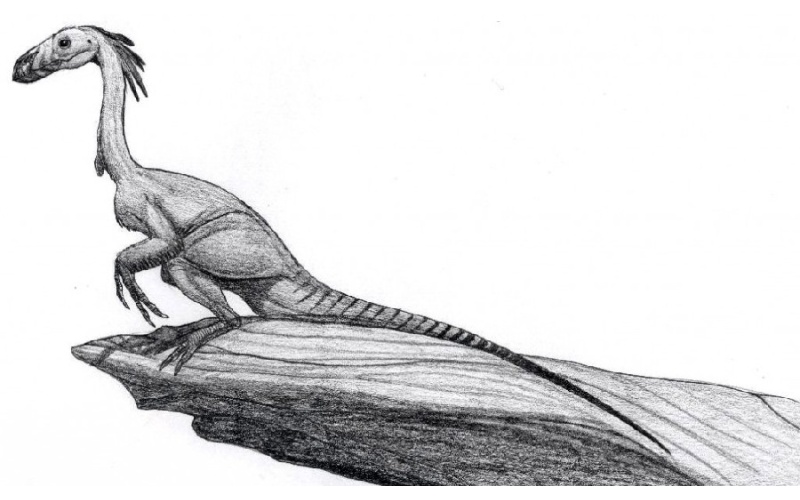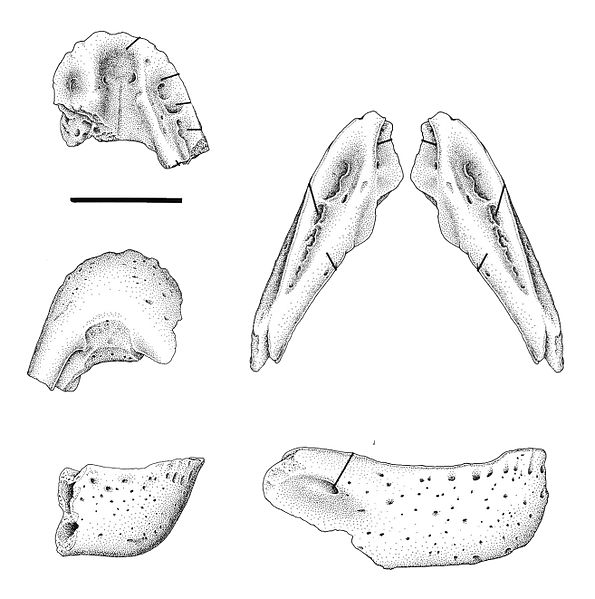Embarking on a journey into the Late Cretaceous Period, we uncover the intriguing life of Caenagnathasia, a lesser-known but captivating dinosaur. Often overshadowed by its larger cousins, this dino offers a unique window into a world long gone, painting a picture of life during a time of vast ecological diversity. With its intriguing features and behaviors, Caenagnathasia captivates both the seasoned paleontologist and the casual dinosaur enthusiast alike.
This ancient creature, whose name means “Recent Jaw from Asia,” highlights the continual surprises that the field of paleontology brings to the table. Discovered in the Bissekty Formation of Uzbekistan in 1994, Caenagnathasia’s discovery adds a layer of complexity to our understanding of the dinosaur era. Notably, its discovery and subsequent studies reveal intricate details about the dinosaur era’s food chain, habitat, and survival strategies.
Caenagnathasia Key Facts
| Keyword | Fact |
|---|---|
| Pronunciation | Say-nah-nay-fay-se-ah |
| Meaning of name | Recent Jaw from Asia |
| Group | Theropoda |
| Type Species | Caenagnathasia martinsoni |
| Diet | Omnivore |
| When it Lived | 93.9 to 72.1 MYA |
| Period | Late Cretaceous |
| Epoch | Turonian to Campanian |
| Length | 2.0 to 3.3 feet |
| Height | Approximately 3.0 to 11.0 pounds |
| Weight | Approximately 2.0 feet |
| Mobility | Moved on two legs |
| First Discovery | 1994 by Philip Currie, Stephen Godfrey and Lev Nesov |
| Described by | 1994 by Philip Currie, Stephen Godfrey and Lev Nesov |
| Holotype | N 401/12457 |
| Location of first find | Bissekty Formation, Uzbekistan |
| Also found in | China |
Caenagnathasia Origins, Taxonomy and Timeline
Caenagnathasia, a name derived from the ancient Greek words for ‘recent’ and ‘jaw’, coupled with ‘Asia’ indicating its geographic origins, beckons us to explore its intriguing lineage. This dinosaur, a member of the Caenagnathidae (Theropoda: Oviraptorosauria), is a testament to the intricate web of life that thrived during the Late Cretaceous Period.

The taxonomic classification of this dino places it within the group of theropods, a clade renowned for their carnivorous diet and bipedal locomotion, though our dino here was an omnivore. Within the theropods, it belonged to the enigmatic group of caenagnathids, which further emphasizes its unique place in the Cretaceous world. The type species, Caenagnathasia martinsoni, was named after Gerbert Genrikhovich Martinson, a paleontologist who made significant contributions to the study of Cretaceous life, especially in the former Soviet Union. This underscores the importance of meticulous scientific discovery of Caenagnathasia.
Traversing the timeline of Caenagnathasia, we find ourselves in the Late Cretaceous Period, specifically from the Turonian to the Campanian. This was a time when the Earth’s continents were still taking shape, and a plethora of life forms were evolving and adapting. During this period, which spanned from approximately 93.9 to 72.1 million years ago, our dino thrived amidst a world teeming with biodiversity.
Discovery & Fossil Evidence
The tale of Caenagnathasia’s discovery is a testament to the relentless pursuit of knowledge. Unearthed in the arid landscapes of Uzbekistan’s Bissekty Formation in 1994, it was a find that illuminated a new aspect of the dinosaur world. Discovered by the collaborative efforts of Philip Currie, Stephen Godfrey and Lev Nesov, this dino’s remains offered a new perspective on the diversity of life during the Late Cretaceous.

Later explorations in China revealed additional pieces of the puzzle, broadening our understanding of this species’ geographical distribution. The fossils, primarily consisting of jaw fragments and skeletal remains, provided a glimpse into the physical structure and dietary habits of this ancient creature. Notably, the preservation of these fossils, though fragmented, has been instrumental in piecing together the life of Caenagnathasia.
The discovery of this dinosaur has not only expanded our knowledge of the Caenagnathidae family but also provided invaluable insights into the broader ecosystem of the time. Each fossil, a jigsaw piece in the grander puzzle of Cretaceous life, enhances our understanding of the biodiversity and ecological dynamics of the Late Cretaceous era.
Caenagnathasia Size and Description
This dino, with its slender and agile form, showcased the characteristic features of a theropod. Its bipedal stance, indicative of a lifestyle that may have involved both hunting and scavenging, speaks of a versatile and opportunistic creature. The skeletal structure, from its elongated neck to its tapered tail, suggests a being that was both swift and graceful.
The limbs of Caenagnathasia, well-suited for movement, hint at a lifestyle that may have involved swift running and perhaps agile maneuvers through its habitat. Its jaws, equipped with teeth suitable for an omnivorous diet, paint a picture of a creature adept at exploiting a wide range of food sources.
Size and Weight of Type Species
Though exact measurements of Caenagnathasia are subject to some debate among paleontologists, we can surmise that it was not among the largest of dinosaurs. Its stature, estimated to be of moderate size, suggests a creature that was both nimble and adaptable. The precise dimensions of this species remain a subject of ongoing research, yet it is believed that it was a creature of substantial presence in its ecosystem.
The Dinosaur in Detail
Caenagnathasia, a fascinating subject of study, reveals several unique features that distinguish it from other members of its clade. As we explore these features, we gain insights into its adaptability and survival instincts.
This dinosaur’s physical characteristics, from its skeletal structure to its potential feeding habits, offer clues to its lifestyle and behaviors. The anatomy of Caenagnathasia, particularly its jaw structure and teeth, suggests a diet that was varied, allowing it to exploit a range of food sources in its environment.
Notable specimens of Caenagnathasia have contributed significantly to our understanding of this species. Each discovery adds a layer of depth to our knowledge, shedding light on the diversity and complexity of dinosaur life.
Contemporary Dinosaurs
In the Late Cretaceous Period, the world of Caenagnathasia was a tapestry of diverse and formidable contemporaries, each playing a distinct role in the ecosystem. This era was not just about the survival of the fittest but also about the intricate relationships and interactions among various species.
Magnirostris, a contemporary of Caenagnathasia, was a creature of notable prowess. With its robust build, it likely competed for resources, presenting a challenge in the struggle for survival. Their encounters, possibly at food sources or territorial boundaries, would have been a display of nature’s unscripted drama.
Linheraptor, another contemporary, was a swift and agile predator. Its presence in the same era suggests a dynamic environment where predator and prey dynamics were in constant flux. Caenagnathasia, with its omnivorous diet and agility, might have found itself both hunter and hunted in this ever-changing landscape.
Machairasaurus, a name synonymous with sharpness, suggests a creature adept at slicing through its environment. Its interactions with Caenagnathasia, whether as a competitor or a co-inhabitant, would have added layers to the complex tapestry of life during this period.
Finally, Huabeisaurus, a contemporary of a different stature, brings diversity to this tableau. Its larger size compared to Caenagnathasia might have meant different ecological niches, allowing for coexistence without direct competition.
This vibrant mosaic of Cretaceous life, with Caenagnathasia at its core, illustrates the rich and varied tapestry of the Late Cretaceous ecosystem. Each species, with its unique characteristics and behaviors, contributed to the dynamic balance of life in an era long past.
Interesting Points about Caenagnathasia
- Discovery in Uzbekistan: Caenagnathasia was first discovered in the Bissekty Formation of Uzbekistan, a region rich in dinosaur fossils.
- Unique Diet: Unlike many theropods, which were primarily carnivorous, this dino was an omnivore, showcasing a diverse feeding habit.
- Geographical Distribution: Later finds in China suggest a wider geographical distribution than initially thought.
- Taxonomic Classification: Its classification within the Caenagnathidae highlights the diversity within the theropod group.
- Adaptability: The physical characteristics of Caenagnathasia, particularly its agility, suggest a highly adaptable creature in the Late Cretaceous ecosystem.
Caenagnathasia in its Natural Habitat
Delving into the world of Caenagnathasia, we find ourselves in a landscape that was both challenging and teeming with life. This dino inhabited a world where adaptation was key to survival, and its characteristics reflect a creature well-suited to its environment.
The Late Cretaceous Period, the time when Caenagnathasia roamed, was characterized by a diverse and dynamic ecosystem. The climate during this era was warmer than today, with lush vegetation and a variety of life forms. The geography of the time, marked by shifting continents and rising sea levels, offered a range of habitats for different species.
Caenagnathasia, with its omnivorous diet, would have been an active participant in the food chain, exploiting a variety of food sources. Its physical attributes, including its mobility and potential speed, suggest a creature capable of both hunting and scavenging. The social behavior of Caenagnathasia, whether it was a solitary or herd animal, remains a topic of interest among researchers.
The presence of Caenagnathasia in its habitat would have had a notable impact on the surrounding ecosystem. As a potentially agile predator and opportunistic feeder, it might have played a significant role in shaping the dynamics of its environment.
Frequently Asked Questions
Caenagnathasia lived during the Late Cretaceous Period, about 93.9 to 72.1 million years ago.
It was first discovered in the Bissekty Formation in Uzbekistan.
Caenagnathasia was an omnivore, feeding on a variety of plant and animal matter.
The name means “Recent Jaw from Asia,” reflecting both its discovery location and its distinctive jaw structure.
This dinosaur was bipedal, moving primarily on its two hind legs.
While there is no definitive evidence, its behavior as either a solitary or social creature is a subject of ongoing research.
Sources
The information in this article is based on various sources, drawing on scientific research, fossil evidence, and expert analysis. The aim is to provide a comprehensive and accurate overview of Caenagnathasia. However, please be aware that our understanding of dinosaurs and their world is constantly evolving as new discoveries are made.
This article was last fact checked: Joey Arboleda, 03-11-2024
Featured Image Credit: dinosaurpictures.org
